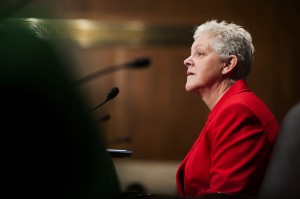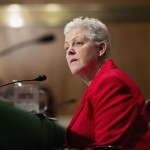With New Head of EPA, Battles With Texas Likely to Continue

Photo by REUTERS /JOSHUA ROBERTS /LANDOV
Gina McCarthy, the new head of the Environmental Protection Agency (EPA), has been the top air quality official at the agency since 2009.
The Environmental Protection Agency’s recently confirmed administrator, Gina McCarthy, gave her first public address at Harvard Law School today. As the head of the EPA’s air and radiation office since 2009, McCarthy has helped write some of the agency’s toughest air pollution regulations. Today she announced her intentions to make a serious effort to combat climate change, and made it clear that effort will require reducing greenhouse gas emissions, which could have big implications for Texas, the top emitter in the country.
With new regulations potentially on the horizon, will the fractious relationship between Texas and the federal government likely continue? Texas Attorney General Greg Abbott (and now candidate for Governor) has spent over $2.5 million suing the federal government. Many of those lawsuits, including 14 which are active, have been directed against the EPA. (Texas lost the latest round, fought over whether the EPA has the right to regulate greenhouse emissions.)
And the state’s U.S. senators, John Cornyn and Ted Cruz, voted against McCarthy’s appointment. However, Texas environmentalists consider her confirmation a victory.
“Gina McCarthy’s confirmation is long-awaited good news for the planet and Texans’ health,” said Luke Metzger, director of the advocacy organization Environment Texas, in a press release. “I am disappointed that Senators Cornyn and Cruz voted to oppose Gina McCarthy’s appointment and chose to side with polluters over public health and the environment.”
As the head of the EPA’s air quality office, McCarthy helped author stricter vehicle emissions standards, the first rule on mercury emissions from power plants, and a rule on cross-state air pollution that was overturned by a federal appeals court. However, that case is now headed to the Supreme Court, which is viewed as a win for the EPA.
Prior to joining the EPA, McCarthy served as the commissioner of the Connecticut Department of Environmental Protection, and was also a top environmental aide for five Massachusetts governors, including 2012 Republican presidential nominee Mitt Romney.
In her Harvard address, McCarthy emphasized that her mission to reduce greenhouse gas emissions comes directly from the top.
“[President Obama] told us to reduce pollution from the power sector,” McCarthy said. “He told us not just to tackle what new facilities ought to look like, but to actually challenge ourselves to work with all of those partners to deliver a power sector that currently exists, that can drive greenhouse gases down. That is exactly what we want to do.”
She said that “those partners” will include states, local communities, businesses and others. McCarthy insisted that she wants the EPA to follow the direction of local communities when addressing environmental problems. She highlighted the cleanup of the harbor in her native Boston as a successful example of local environmental stewardship.
The Texas power industry and state political leaders may not be receptive to EPA overtures if new rules on carbon emissions are at stake. Last month, Texas comptroller Susan Combs told the Dallas Morning News that proposed national caps on greenhouse gas emissions “could wind up gutting the coal industry, which generates more than $6.2 billion in the Texas economy each year.” The CEO of Luminant, one of Texas’ largest power generators, indicated that the details of federal rules, and the speed at which they are rolled out, would determine the power industry’s ability to adapt.
McCarthy contends that in the long term, requiring lower carbon emissions will spur changes in the energy industry that will ultimately contribute to a healthy economy, and better public health.
“For too long, we’ve been focused on this false choice,” she said. “It’s not a choice between the health of our children and the health of the economy … Today, the truth is that we need to embrace cutting carbon pollution as a way to spark business innovation. We need to cut carbon pollution to grow jobs. We need to cut carbon pollution to strengthen the economy.”
According to McCarthy, air pollutant emissions fell 68 percent from 1970 (the year that President Nixon founded the EPA) to 2011. At the same time, the U.S. domestic product grew 212 percent, and the U.S. population increased by 52 percent.
Under her leadership, it is already clear that the economic nature of environmental problems will be a strong component of the EPA’s message.
“Climate change isn’t an environmental issue,” McCarthy said. “It is a fundamental economic challenge for us. It is a fundamental challenge internationally, and we need to embrace that challenge. I am quite sure that following Hurricane Sandy, nobody looked at that hurricane as an environmental challenge. They looked at it as an economic devastation.”

